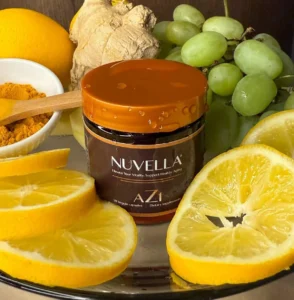NUVELLA HEALTH

The Science of Wellness: AZ1 Components
NAD+
Metabolomics-based studies of aging have identified NAD+ as a central metabolic intermediate linked to many of the hallmarks of aging. NAD+ is a cellular coenzyme that plays an essential role in both metabolic and signaling reactions. During its role in metabolism, NAD+ participates in redox reactions leading to the formation of ATP.
This combination of metabolic and cell-signaling functions means that NAD+ acts as a metabolic messenger providing an important link between the energy status of the cell and downstream signaling for appropriate cellular adaptation to bioenergetic stress.
Therefore, a proper maintenance of NAD+ levels is required to maintain tissue homeostasis and stress response. Low NAD+ contributes to aging because NAD+ serves as an exclusive co-substrate for two key families of enzymes that affect cellular repair and longevity—the sirtuins (SIRTs) and the poly(ADP-ribose) polymerases (PARPs). These enzyme families regulate many signaling processes associated with cellular health and longevity and are directly dependent on NAD+ availability to perform their functions.
Conlon NJ. The Role of NAD+ in Regenerative Medicine. Plast Reconstr Surg. 2022 Oct 1;150(4 Suppl ):41S-48S. doi: 10.1097/PRS.0000000000009673. Epub 2021 Sep 28. PMID: 36170435; PMCID: PMC9512238.
Resveratrol
Resveratrol has antioxidant, anti-inflammatory, immunomodulatory, glucose and lipid regulatory, neuroprotective, and cardiovascular protective effects, therefore, can protect against diverse chronic diseases, such as cardiovascular diseases (CVDs), cancer, liver diseases, obesity, diabetes, Alzheimer’s disease, and Parkinson’s disease.. Resveratrol, therefore, has been regarded as a potent candidate for the development of nutraceuticals and pharmaceuticals to prevent and treat certain chronic diseases.
Resveratrol is a plant compound belonging to a group called polyphenols. It’s known for its antioxidant properties and is found in various plants, particularly the skin of grapes, berries, and peanuts.
Meng X, Zhou J, Zhao CN, Gan RY, Li HB. Health Benefits and Molecular Mechanisms of Resveratrol: A Narrative Review. Foods. 2020 Mar 14;9(3):340. doi: 10.3390/foods9030340. PMID: 32183376; PMCID: PMC7143620.
Curcumin
Curcumin, the active compound in turmeric, is renowned for its powerful anti-inflammatory and antioxidant properties. It supports joint health, aids in digestion, and helps protect the body from oxidative stress. Curcumin has also been studied for its potential to support brain function and overall immune health, making it a key ingredient for those seeking natural ways to promote long-term wellness and vitality.
Hewlings SJ, Kalman DS. Curcumin: A Review of Its Effects on Human Health. Foods. 2017 Oct 22;6(10):92. doi: 10.3390/foods6100092. PMID: 29065496; PMCID: PMC5664031
Alpha-Lipoic Acid
Alpha-lipoic acid (ALA) is a powerful antioxidant known for its ability to support cellular energy production and fight oxidative stress. It plays a key role in maintaining healthy nerve function, regulating blood sugar levels, and enhancing skin health by neutralizing free radicals. ALA is both water- and fat-soluble, allowing it to work throughout the body, making it a versatile and valuable ingredient in promoting overall wellness and healthy aging
Superti F, Russo R. Alpha-Lipoic Acid: Biological Mechanisms and Health Benefits. Antioxidants (Basel). 2024 Oct 12;13(10):1228. doi: 10.3390/antiox13101228. PMID: 39456481; PMCID: PMC11505271
Biotin
Biotin, also known as vitamin B7, is essential for supporting healthy hair, skin, and nails. It plays a crucial role in converting food into energy by aiding in the metabolism of fats, carbohydrates, and proteins. Biotin also supports nervous system health, making it a vital nutrient for maintaining overall wellness and a radiant, energized appearance from within.